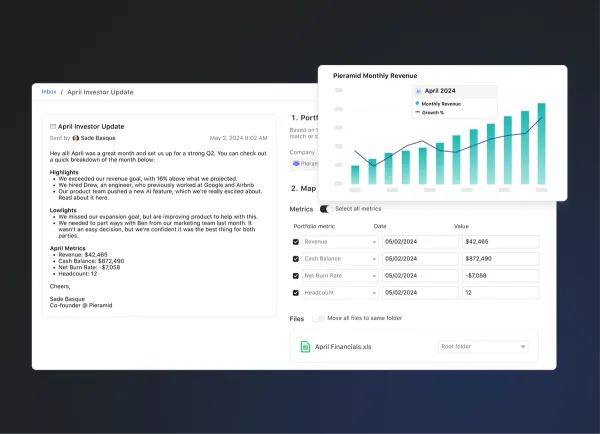
Creating a pitch deck that captivates investors is crucial for any startup founder looking to secure funding. But what slides should you include to make the strongest impression? In this article, we'll walk you through the ten essential slides every pitch deck needs. From outlining your problem statement to showcasing your financials, we'll provide you with a roadmap to crafting a compelling narrative that captures investor interest and sets the stage for successful fundraising. Get ready to transform your pitch deck and elevate your startup's potential.
Related resource: Our Teaser Pitch Deck Template
Why Are Pitch Decks Important?
Pitch decks are crucial because they offer a concise, visually appealing format to present a startup's business plan to potential investors. They are the preferred format for several reasons:
- Clarity and Focus: A well-structured pitch deck highlights the most critical aspects of your business, such as the problem, solution, market opportunity, and financial projections. This ensures that investors quickly grasp the essence of your startup.
- Engagement: Visual elements like graphs, charts, and images make the presentation more engaging and easier to follow. This helps maintain the attention of investors, who often review numerous pitches.
- Efficiency: Pitch decks allow founders to convey essential information succinctly. By adhering to guidelines like the 10/20/30 rule, presentations remain brief and impactful, respecting the time constraints of busy investors.
- Storytelling: They provide a narrative structure that helps tell your startup's story compellingly. This narrative approach helps build a connection with investors, making your pitch more memorable.
Related resource: Seed Round Pitch Deck
The 10/20/30 Rule
The 10/20/30 Rule, introduced by venture capitalist Guy Kawasaki, is a guideline designed to help create effective and engaging pitch decks. According to this rule, a pitch deck should adhere to three key principles:
- Ten Slides: Limit your presentation to ten slides. This constraint forces you to focus on the most essential information, ensuring clarity and preventing information overload for your audience.
- Twenty Minutes: Aim to deliver your presentation within twenty minutes. This time frame is optimal for maintaining investors' attention while providing enough time for discussion and questions.
- Thirty-Point Font: Use a minimum font size of thirty points for your text. This ensures that your slides are easily readable from a distance and encourages you to be concise, using only the most important points.
Adhering to the 10/20/30 Rule is crucial for several reasons. Keeping the presentation short and engaging helps maintain the audience's interest. It also ensures that your key messages are communicated clearly and effectively, making it easier for investors to understand and remember the critical aspects of your business. By following this rule, you can create a pitch deck that is both powerful and persuasive.
Related resource: Slides in a Pitch Deck
Slides to Include in Your Pitch Deck
When it comes to pitch decks, less is more. A concise and focused presentation allows you to communicate your startup’s value proposition effectively without overwhelming your audience. Including only the most essential slides ensures your message is clear and impactful. Here are the ten key slides you should include in your pitch deck:
Related resource: Pitch Deck Design
Title Slide
The title slide is your first impression and sets the stage for the entire pitch. It should be clean, professional, and include the following key elements:
- Company Name: Clearly state the name of your startup to establish brand identity.
- Your Name and Title: Include your name and title to personalize the presentation and establish credibility.
- Contact Information: Provide your email address and phone number so investors can easily reach out for follow-ups.
- Company Logo: Display your logo to reinforce brand recognition and professionalism.
- Tagline or Mission Statement: A brief, compelling tagline or mission statement can succinctly convey your company’s purpose and vision.
The title slide is important because it sets the tone for the rest of your presentation. It provides essential information at a glance and makes it easy for investors to remember who you are and how to contact you.
Example
- Airbnb: Airbnb's pitch deck title slide prominently features their logo, the company name, and a tagline: "Book rooms with locals, rather than hotels." This immediately communicates their unique value proposition.
Problem Statement
The problem statement slide is critical because it sets the stage for why your startup exists. It should clearly define the problem your product or service aims to solve, making it relatable and compelling to potential investors. To make a strong introductory statement, include the following metrics:
- Market Size: Quantify the problem by highlighting the size of the market affected. This shows the potential scope and impact of your solution.
- Prevalence: Use statistics to illustrate how widespread the problem is. For instance, stating that "70% of small businesses struggle with cash flow management" makes the problem tangible and urgent.
- Financial Impact: Provide data on the financial consequences of the problem. For example, "Businesses lose $100 billion annually due to inefficient inventory management" underscores the economic significance.
- User Pain Points: Highlight specific pain points experienced by your target audience. This helps investors understand the real-world challenges and frustrations that your solution addresses.
Importance
These metrics are important because they:
- Establish Relevance: Demonstrate that the problem is significant and affects a large number of people or businesses.
- Quantify Opportunity: Show investors the potential market size and financial opportunity if the problem is solved.
- Create Urgency: Emphasize the immediate need for a solution, making your startup's mission compelling and timely.
Examples
- Airbnb: In their pitch deck, Airbnb highlighted the problem by stating, "Price is an important concern for customers booking travel online." They supported this with data on the cost of hotel stays and the growing trend of people seeking more affordable options.
- LinkedIn: LinkedIn’s pitch deck focused on the problem of professionals struggling to maintain effective networking. They presented data on the limitations of existing solutions like traditional resumes and business cards, highlighting the need for a modern professional networking platform.
Solution or Product Description
The solution or product description slide is your opportunity to showcase how your startup addresses the problem identified in the previous slide. To capture the attention of investors, your product needs to be conveyed clearly, compellingly, and convincingly. Here’s how to do it:
- Clear Description: Provide a concise and clear description of your product or service. Avoid jargon and ensure that even someone unfamiliar with your industry can understand the solution.
- Value Proposition: Highlight the unique value proposition of your product. Explain what sets it apart from existing solutions and why it is better or more effective.
- Key Features: Showcase the main features and functionalities that solve the problem. Use bullet points or visuals to make these features easily digestible.
- Benefits: Focus on the benefits your product provides to users. Explain how it improves their lives or businesses, making it indispensable.
- Visuals and Demos: Use images, screenshots, or short video demos to demonstrate your product in action visually. This helps investors see the product’s potential and functionality.
Importance
Conveying your product effectively is crucial because:
- Demonstrates Feasibility: Shows that you have a viable solution to the problem.
- Builds Credibility: Demonstrates your understanding of the market and user needs.
- Engages Investors: A compelling presentation captures interest and encourages investors to learn more.
Examples
- Mint: Mint’s pitch deck described their personal finance tool by emphasizing how it simplifies money management. They highlighted key features such as budget tracking and financial goal setting, supported by screenshots of the app interface, making the value proposition clear and compelling.
Market Opportunity
The market opportunity slide is crucial in demonstrating your startup's potential for growth and profitability. Investors need to see that there is a significant and growing market for your product or service. Here’s how to effectively present this information:
- Market Size: Show the total addressable market (TAM), serviceable available market (SAM), and serviceable obtainable market (SOM). These figures illustrate the overall market size and the portion your startup aims to capture.
- Growth Trends: Highlight industry trends that indicate market growth. This could include increasing adoption rates, technological advancements, or shifts in consumer behavior that favor your solution.
- Customer Segments: Identify and describe your target customer segments. Provide data on their demographics, needs, and purchasing behaviors.
- Competitive Landscape: Show the current state of the market, including major competitors and gaps that your startup can exploit. Use charts or graphs to illustrate market share distribution.
- Economic Indicators: Include relevant economic indicators, such as market growth rates, average customer spending, and profitability margins. These data points help quantify the opportunity.
Importance
The market opportunity slide is important because:
- Validates Potential: Demonstrates that there is a real and significant demand for your product.
- Attracts Investors: Investors are likelier to invest in startups operating in large and growing markets.
- Guides Strategy: This helps investors understand your strategic positioning and market entry plans.
Examples
- WeWork: WeWork’s pitch deck presented the growing demand for flexible workspaces. They included data on the rise of freelancers, remote work trends, and the shift away from traditional office spaces, demonstrating a significant market opportunity.
Business Model
The business model slide is crucial for showing investors how your startup plans to generate revenue and achieve profitability. It provides a clear picture of the financial mechanics of your business, demonstrating that your venture is viable and potentially lucrative. Here’s what you should include:
- Revenue Streams: Detail the different ways your business will make money. This could include direct sales, subscription fees, licensing, advertising, or other revenue models.
- Pricing Strategy: Explain your pricing model and how it aligns with your revenue streams. Include any tiered pricing, freemium models, or volume discounts.
- Cost Structure: Outline your key costs, including fixed and variable expenses. This helps investors understand your cost base and how it scales with growth.
- Profit Margins: Provide data on expected profit margins. This shows how much of your revenue translates into profit after expenses.
- Customer Acquisition Cost (CAC): Present the cost of acquiring a new customer. This metric is crucial for understanding the efficiency of your sales and marketing efforts.
- Lifetime Value (LTV): Estimate the average revenue generated from a customer over the lifespan of their engagement with your business. LTV helps investors gauge long-term profitability.
- Break-even Analysis: Show when your startup is expected to become profitable. This includes the break-even point where total revenues equal total costs.
Importance
These data points are important because:
- Demonstrate Viability: Show that you have a realistic and thought-out plan for generating revenue.
- Build Credibility: Provide concrete financial metrics that back up your business strategy.
- Attract Investment: Help investors understand the financial potential and risk associated with your startup, making it easier for them to commit funds.
Examples
- YouTube: In their early pitch decks, YouTube highlighted their ad-supported revenue model. They explained how they planned to monetize user-generated content through targeted advertising, showcasing potential ad revenue projections based on user engagement metrics.
Go-to-Market Plan
The go-to-market (GTM) plan slide outlines your strategy for launching your product and achieving market penetration. It's crucial because it shows investors how you plan to convert your vision into reality, driving adoption and growth. Here’s what you should include:
- Market Segmentation: Identify the specific segments of the market you will target first. Explain why these segments are your initial focus and how they will help you build momentum.
- Marketing Strategy: Describe your marketing tactics and channels, such as digital marketing, social media, content marketing, partnerships, and PR. Highlight how you will reach and attract your target audience.
- Sales Strategy: Explain your sales approach, including direct sales, online sales, channel partnerships, or a combination. Detail your sales process and how you will convert leads into customers.
- Distribution Channels: Outline the channels through which your product will be delivered to customers. This could include online platforms, retail partnerships, or direct shipping.
- Customer Acquisition: Provide a plan for acquiring and onboarding new customers. Include customer acquisition costs (CAC) and expected customer acquisition methods.
- Timeline and Milestones: Present a timeline of key milestones, such as product launch dates, marketing campaigns, and sales targets. This helps investors see your progress and plan for scaling.
Importance
The go-to-market plan is important because:
- Shows Preparedness: Demonstrates that you have a clear and actionable strategy for entering the market.
- Reduces Risk: Provides investors with confidence that you have thought through how to gain market traction, reducing perceived investment risk.
- Highlights Growth Path: Maps out how you will achieve growth, helping investors understand the potential return on investment.
Examples
- Dropbox: Dropbox’s GTM plan focused on a viral growth strategy through their referral program, where users received additional storage for referring new users. This strategy effectively lowered customer acquisition costs and accelerated user adoption.
Known Competitors
Understanding your competitors is crucial for positioning your startup effectively in the market. This slide should provide an overview of the competitive landscape, showing investors that you are aware of existing alternatives and have a clear strategy to differentiate your product. Here’s what to include:
- Competitor Overview: List your main competitors, including direct and indirect ones. Briefly describe each, focusing on their strengths and market position.
- Competitive Analysis: Use a comparative table or chart to highlight key features, pricing, market share, and other relevant metrics. This visual aid helps investors quickly grasp how their competitors operate.
- Unique Value Proposition: Clearly articulate what sets your product apart. Highlight your unique features, benefits, or technological advancements that give you a competitive edge.
- Market Positioning: Explain how you position your product in the market relative to your competitors. Discuss your target audience and how your product better meets their needs.
- Barriers to Entry: Identify any barriers to entry you have established, such as patents, proprietary technology, or exclusive partnerships, which protect your market position from competitors.
Importance
Understanding your competitors and highlighting your unique advantages is important because:
- Informs Strategy: Demonstrates that you deeply understand the market and have strategically positioned your product to stand out.
- Builds Credibility: This shows investors that you are well-prepared and have completed your competitive landscape homework.
- Reduces Risk: This helps investors see that you have a plan to overcome competition, reducing perceived investment risk.
Examples
- Uber: Uber’s pitch deck provided a clear overview of the transportation market, comparing its service to traditional taxis and other ride-sharing platforms. It emphasized its superior user experience, ease of use, and innovative pricing model.
Financials and Exit Strategy
The financials and exit strategy slide is vital for demonstrating the potential return on investment (ROI) to investors. This slide should detail your financial projections, funding requirements, and exit strategy. Here’s what to include:
- Financial Projections: Provide detailed forecasts of your revenue, expenses, and profits for the next 3-5 years. Include key financial metrics such as gross margin, net profit, and EBITDA.
- Funding Requirements: Specify how much funding you seek, what it will be used for, and how it will drive growth. Break down the use of funds into categories like product development, marketing, and operations.
- Break-even Analysis: Show when your startup is expected to break even and start generating profit. This helps investors understand the timeline for financial viability.
- Exit Strategy: Outline potential exit strategies, such as acquisition, merger, or IPO. Explain how and when you plan to "buy out" investors, providing them with a return on their investment.
Importance
Showing how you plan to buy out investors in the future is important because:
- Demonstrates ROI: Investors want to know how and when they will see a return on their investment. An exit strategy provides a clear path to achieving this.
- Reduces Risk: A well-defined exit strategy reduces the perceived risk by showing that you have thought through the end game and have realistic plans for achieving it.
- Builds Confidence: Financial projections and a clear exit strategy build confidence in your business acumen and the long-term viability of your startup.
The Team
The team slide is one of the most critical components of your pitch deck because it highlights the people behind the startup. Investors often invest in teams as much as they invest in ideas, believing that a strong, experienced, and capable team is more likely to execute the business plan successfully. Here’s what to include:
- Key Team Members: Introduce your core team members, including their names, titles, and roles within the company.
- Relevant Experience: Highlight each team member's relevant experience and expertise. Include past achievements, previous startups, industry experience, and any notable accomplishments.
- Complementary Skills: Show how the team’s skills complement each other. This demonstrates that your team can address various aspects of the business.
- Advisors and Board Members: If applicable, include key advisors and board members who bring additional expertise and credibility to the team.
Importance
Showing how your team is uniquely qualified to solve the problem is important because:
- Builds Credibility: Demonstrates that your team has the expertise and experience to execute the business plan and overcome challenges.
- Instills Confidence: Investors gain confidence knowing that the team can deliver on the vision and achieve the startup’s goals.
- Highlights Leadership: Emphasizes the leadership and strategic thinking behind the startup, making it more attractive to investors.
- Mitigates Risk: A strong, competent team reduces the perceived risk of the investment, as investors trust that experienced professionals are steering the company.
Why Now
The "Why Now" slide is essential for conveying the urgency and timeliness of your investment opportunity. This slide should explain why the current moment is the perfect time for your startup to succeed and why investors should act quickly to seize this opportunity. Here’s what to include:
- Market Trends: Highlight current market trends that favor adopting your product or service. This could include technological advancements, regulatory changes, or shifts in consumer behavior.
- Industry Growth: Provide data on your industry's rapid growth, demonstrating that now is the time to enter the market.
- Competitive Landscape: Explain how the competitive landscape is evolving and why your startup is uniquely positioned to capitalize on this moment.
- Urgency Factors: Identify any factors that make immediate action crucial, such as a limited window of opportunity, first-mover advantage, or a pressing market need.
- Recent Developments: Mention recent developments or milestones your startup has achieved that indicate readiness for rapid growth, such as product launches, strategic partnerships, or pilot program successes.
Importance
Showing that the investment is timely and the right choice is important because:
- Creates Urgency: Investors are more likely to act quickly if they see a time-sensitive opportunity. Demonstrating urgency helps accelerate the decision-making process.
- Enhances Relevance: Proving that your startup is aligned with current trends and market needs makes your business proposition more relevant and compelling.
- Reduces Risk: Investors feel more confident investing in a startup that is positioned to take advantage of current market conditions, reducing perceived risk.
- Capitalizes on Momentum: Highlighting why now is the ideal time to invest shows that your startup is poised for growth, leveraging momentum to drive success.
Examples
- Slack: Slack’s pitch deck showcased the shift towards remote work and the growing need for effective team communication tools, demonstrating the immediate relevance and necessity of their product.
Connect, Fundraise, and Update Your Investors with Visible
Putting together a pitch deck is only the start of a successful fundraise. You need to find the right investors, manage conversations, and distribute your pitch deck. To get started with your next fundraise check out our investor database to help you find your investors.
Looking for best practices for sharing your pitch deck? Check out our template for sharing your pitch deck here.
Related resource: Tips for Creating an Investor Pitch Deck




